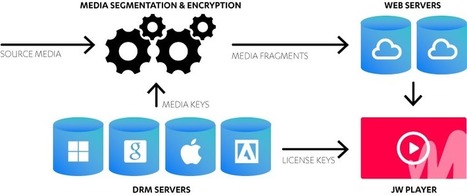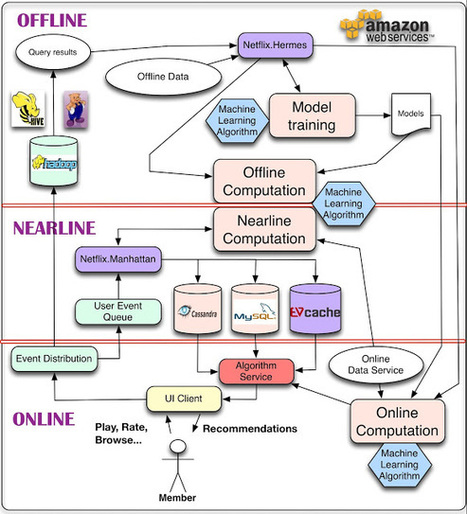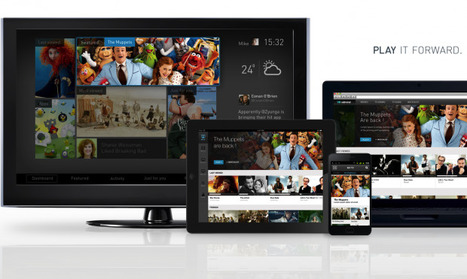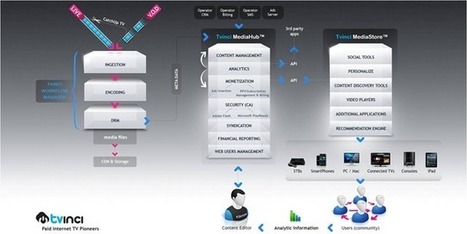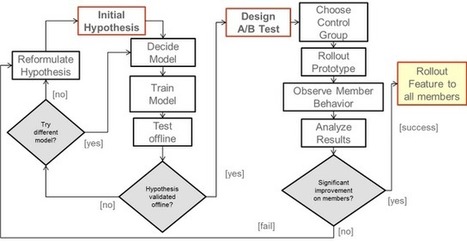 Your new post is loading...
 Your new post is loading...
With the recent announcements from Apple/Netflix and Mozilla, all modern desktop browsers will soon support the proposed HTML Encrypted Media Extensions (EME) standard. EME provides a standardized approach for playing encrypted content in HTML5. One application of encrypted video is the enforcement of Digital Rights Management (DRM) on paid video content. Many content owners (film studios, sports leagues, etc.) mandate using DRM to distribute their content online.
What does all of this alphabet soup mean for users? In short, the EME standard enables publishers to deliver premium video to browsers without the need for plugins. To date, doing DRM in the browser requires the Adobe Flash, Microsoft Silverlight or Google Widevine plugins. These plugins use non-interoperable file formats, protocols and DRM key systems, creating fragmentation. EME solves (most of) these issues, enabling premium video in HTML5 using a single file format and streaming protocol.
LG Electronics is introducing 12 new Ultra HD television models, and all of them will be able to stream content in Ultra HD 4K format from Netflix later this year — providing four times the resolution of regular HD. LG’s 2014 Ultra HD TVs include an HEVC codec chip, for decoding video signals in both MPEG-4 H.264 and HEVC H.265 formats, in either 30 or 60 frames per second. The company didn’t announce pricing or availability. Its current 4K TVs range from $5,200 for a 65-inch TV up to $20,000 for the 85-inch model.
Over the last year, we've been collaborating with other industry leaders on three W3C initiatives which are positioned to solve this problem of playing premium video content directly in the browser without the need for browser plugins such as Silverlight. We call these, collectively, the "HTML5 Premium Video Extensions"
In our previous posts about Netflix personalization, we highlighted the importance of using both data and algorithms to create the best possible experience for Netflix members. We also talked about the importance of enriching the interaction and engaging the user with the recommendation system. Today we're exploring another important piece of the puzzle: how to create a software architecture that can deliver this experience and support rapid innovation. Coming up with a software architecture that handles large volumes of existing data, is responsive to user interactions, and makes it easy to experiment with new recommendation approaches is not a trivial task. In this post we will describe how we address some of these challenges at Netflix.
Netflix and YouTube have teamed up to launch DIAL, a protocol that helps developers of second-screen apps to discover and launch applications on smart TVs and connected devices. The effort is already getting support from a number of notable players, including Samsung, Sony, Hulu and the BBC. DIAL could become a key piece in efforts to establish an open alternative to Apple’s AirPlay. YouTube and Netflix have been collaborating quietly on these efforts for months. Word first got out when some inquisitive users discovered traces of DIAL back in December. The DIAL website publicly launched with little fanfare and a brief mention on Engadget earlier this month, and now, Netflix is for the first time sharing some key details of the project with GigaOM. DIAL stands for “discovery and launch,” which pretty much sums up what the protocol is meant to do. DIAL-enabled second screen apps will be able to discover DIAL-ready first-screen devices in the same network and launch apps on them. That may sound trivial, but it’s actually solving a big problem for second screen app developers.
New product suite achieves new levels for ultra-low-bandwidth Internet video – enabling delivery of full HD 3D, StudioHD, and UltraHD (4K Video) : • eyeIO StudioRes. Built to Hollywood's 4K requirements, eyeIO StudioRes delivers UltraHD, studio-grade H.264 videos (10 bit, 4:2:2 video, xvYCC). eyeIO StudioRes is available for both package media and Internet streaming delivery to bring no-compromise pictures to the next generation of 85" and larger UltraHD/4K screens.
• eyeIO.265. Brings eyeIO technology to the coming H.265 HEVC ITU standard and long-term industry efforts.
• eyeOS. The eyeIO video operating system. A superior, true UNIX™ Operating System featuring advanced kernel enhancements achieving ultra-stability, bare-metal virtualization performance, automatic load-balancing transcoding, closed-environment security, elastic scalability, and advanced 4K video processing including native support for the forthcoming Interoperable Master Format (IMF). eyeOS will be available in beta form for larger enterprises in the spring of 2013.
Netflix, it seems, is to cloud computing what Google and Facebook are to distributed systems, generally. Today, Netflix has open sourced its latest technology for keeping its cloud-hosted applications running — a set of libraries, called Hystrix, that is designed to manage interactions between the myriad services that comprise the company’s distributed architecture. If you’re building service-oriented architectures in the Amazon Web Services cloud, it might be worth a look. Hystrix actually stems from earlier work to add resilience to the Netflix API, the means by which many customer-facing applications access the services they need to run. As Christensen explained in a February 2012 blog post, services are distributed across thousands of instances in AWS, and if there are problems with those services — such as high latency or failed connections between them — it can wreak havoc on the Netflix API and seriously affect the performance of all the applications that depend on it.
Tel Aviv-based startup Vidmind came out of stealth today and debuted its cloud-based TV solution, which lets operators, broadcasters and retailers essentially create a white labeled version of Netflix. The company provides an Android-based set top box that can be branded for any company, cloud infrastructure to build a streaming TV service, back-end management for operators, clients for multiple platforms including mobile tablet and PC, and built-in second screen and social features so viewers can interact around content. Vidmind was started by Danny Peled, the founder of video company GooMe, which developed apps for broadcast providers and counted Vodafone and Orange as customers. ”At the end of our time at GooMe we decided that we wanted to create a platform for OTT [over-the-top content],” Peled said. “We thought that there is big potential for a fully hosted solution for TV services.” The company lets retailers, broadcasters or content creators create a cloud-based video-on-demand (VOD) and live streaming hub, which customers can access on a subscription basis. More info : http://www.vidmind.com
Now that you intensively crawled through part 1 of this blog-post and asked yourself all the right questions intended to avoid common OTT-traps, we can safely presume that you are ready to spend some (or a lot of) time and money on launching your own multiscreen OTT service. So it’s definitely time to choose your bricks, mortar and trowels... As multiscreen OTT/TV Everywhere offers do proliferate while each video tradeshow approaches and connected devices multiply, it’s difficult to monitor all of them and get a 100% accurate idea on who’s got the best offer. Basically your ideal technical partner will most likely be a unique target depending on your background (telco/content owner/TV channel…), your needs (target devices, business models, time to market…), your workflow constraints (CMS, billing, deployed transcoding engines, already deployed apps…) and your budget. Nevertheless, what I tried to do first is to isolate a list of actors whose offer is end-to-end and sufficiently versatile to cover the most common use cases and devices, then provide a complementary list with actors who provide less information but are also known in this market, and then wrap up the post with a bunch of ideas on how you could DoItYourself with less integrated/locking-in solutions. This way, you will end-up with a complete panorama of available technical solutions in mind.
Today, Netflix announced OpenConnect, a way for Internet Access providers to extend Netflix own CDN. This approach is very much in line with the trend that Jet-Stream predicted: Content Publishers want to be in full control of their workflow chain, right down to delivery. Next to telco CDNs, publisher CDNs are yet another potential threat to Internet CDNs whose best effort infrastructure simply does not live up to the expectations and requirements from premium content providers. Maybe even a bigger threat since this is a massive signal to the CDN industry that content publishers are not just technically able but also have the strategy to directly work with access providers. This is their customers saying: let's cut out the man in the middle. READ OpenConnect webpage outside US : http://ip.fi/%7Ekajtzu/openconnect%20site%20dump.pdf
Last week, Google said it was trying to tackle one of the hardest problems on the internet -- video Discovery. Looking at consumer video services (Netflix, Hulu, Amazon and even GoogleTV) and their second screen counterparts (Matcha, Fanhattan, BuddyTV, etc), the admission of the challenge is painfully evident in the user interface the consumer faces and the result of the Discovery process. But let's back up a bit first. What is Discovery? How does it relate to Search and Recommendation? I think we will find wide agreement that the concept of Search is one where you know what you are looking for and are trying to find it. Now this can be more complex than "Where can I find a legal version of Mission Impossible: Ghost Protocol that I can watch in my living room right now?" (which itself can be challenging in today's service offerings). It is not usually as complex as the problem Shazam solves in the music industry ("what is the name of that song that sounds like..."), but can be difficult (I know the actor who was in the movie or what it was about). Search is decidedly a "lean forward" experience, and as most of us have found out over the last 5 years, it incredibly difficult to implement on a 10-foot remote experience, with various virtual keyboards or fancy remotes trying to help us solve this problem.
|
Could Netflix change its video streaming service to use a P2P architecture, in order to save money on content delivery and sidestep peering conflicts with ISPs like Comcast?
That’s a possibility raised by Netflix CEO Reed Hastings in a blog post Thursday, which urged the FCC to make peering part of new net neutrality regulations. ISPs want Netflix to pay for delivering traffic to their customers because the company doesn’t consume as much traffic as it delivers — to which Hastings replied: “Interestingly, there is one special case where no-fee interconnection is embraced by the big ISPs — when they are connecting among themselves. They argue this is because roughly the same amount of data comes and goes between their networks. But when we ask them if we too would qualify for no-fee interconnect if we changed our service to upload as much data as we download (in other words, moving to peer-to-peer content delivery) — thus filling their upstream networks and nearly doubling our total traffic — there is an uncomfortable silence.”
This brings up an interesting question: Could Netflix actually do that?
Kaltura has long enabled service providers, universities, enterprises, and media companies to deliver video to viewers, with an extensible platform for publishing, distributing, and monetizing content. But for the most part, while it provided a player and CMS, it was up to those companies themselves to do the work of building their sites and readying them for video. Well, no longer. Kaltura is releasing a new product, called MediaGo, which is aimed primarily at the growing number of media partners who wish to quickly roll up an end-to-end video platform and customize it. This so-called “Netflix-in-a-box” portal enables those customers to quickly start serving up ad-based and subscription video services without having to build any infrastructure of their own.
The Web standards group is going ahead with its Encrypted Media Extensions technology despite some opposition, arguing it's a step in the right direction. The World Wide Web Consortium has decided to go ahead with a technology that will let companies like Netflix stream encrypted video using Web sites -- against the wishes of the Free Software Foundation, Electronic Frontier Foundation, and 25,600 petition signatories. The Web standards group announced the move Thursday, to nobody's surprise. Entertainment-industry players had approached the group three years ago to discuss the technology, Microsoft has been helping develop it, and Google already has built the specification, called Encrypted Media Extensions (EME) into Chrome. The standard doesn't actually handle encryption and digital rights management (DRM) to govern who gets to see or copy video. Instead, it provides a standard mechanism that lets a browser call upon a plug-in that handles the work. In other words, it enables encryption but doesn't do the encryption itself.
Neil Hunt is likely the most important Netflix executive that nobody's ever heard of. While everyone in tech media knows CEO Reed Hastings and Chief Content Officer Ted Sarandos, Hunt's kept a low profile despite the pivotal position he holds as the company's chief product officer. Hunt looks after the video service's technology, including the streaming platform, as well as the tech behind the new feature announced yesterday, which will enable subscribers to share what they watch with their Facebook friends. Hunt also oversees the unprecedented amount of user data that Netflix sits on. The data helps his team create the algorithms that support Netflix's recommendation features. At a time when the cost of licensing content is spiking, Hunt said in an exclusive interview withThe Verge that these recommendations help Netflix and its subscribers get the most out of Netflix's video library by suggesting titles that customers are more likely to enjoy. Hunt also talked about those nasty holiday site outages, why Hollywood and Web movie distributors need better supply-chain technology, and why he thinks the film industry places too much emphasis on pixel counts when the sweet spot for improving viewing quality is higher frame rates.
Netflix Open Connect, the single purpose video content delivery network launched last year, is now delivering the majority of Netflix international traffic and is growing at a rapid pace in the domestic market.
Netflix Open Connect is now widely deployed around the world, serving the vast majority of Netflix video in Europe, Canada and Latin America, and a growing proportion in the US, where Netflix has over 25 million streaming members.
Now available through Open Connect partners, Netflix Super HD is the highest quality video format offered by Netflix, providing an even better picture on 1080p HDTVs. In the US, Netflix is also for the first time offering a small number of titles streaming in 3D through Open Connect partners.
For Netflix vice-president of digital supply chain Kevin McEntee, the US-based video streaming company's shift to using the cloud for transcoding its massive content library comes down to a modern take on the fable of the tortoise and the hare. Or, as he told the audience at the AWS re:Invent conference in Las Vegas last week, it's like a choice between moving a room full of people to another city by using expensive high-performance Ferraris or a fleet of somewhat more humble Toyota Priuses.
You most likely read the brief story on Gigaom about Netflix quietly rolling out some second screen functionality for the PS3 implementation of their streaming service. So the real question here is simple: Is this Netflix experiment the sign of things to come from Netflix based on (boring) utility features (Simple), or is this the tip of the second screen iceberg of commercial opportunity from the largest streaming service in the world (Stimulating, Social, Discovery)? READ ALSO : http://gigaom.com/video/netflix-second-screen/
In part one of this blog post, we detailed the different components of Netflix personalization. We also explained how Netflix personalization, and the service as a whole, have changed from the time we announced the Netflix Prize.The $1M Prize delivered a great return on investment for us, not only in algorithmic innovation, but also in brand awareness and attracting stars (no pun intended) to join our team. Predicting movie ratings accurately is just one aspect of our world-class recommender system. In this second part of the blog post, we will give more insight into our broader personalization technology. We will discuss some of our current models, data, and the approaches we follow to lead innovation and research in this space. The goal of recommender systems is to present a number of attractive items for a person to choose from. This is usually accomplished by selecting some items and sorting them in the order of expected enjoyment (or utility). Since the most common way of presenting recommended items is in some form of list, such as the various rows on Netflix, we need an appropriate ranking model that can use a wide variety of information to come up with an optimal ranking of the items for each of our members.
The recent announcement by Netflix to phase out third-party CDNs in favor of an open-source software/hardware solution for access networks has generated a lot of speculation in the market. Is Netflix launching its own CDN? Why doesn’t Netflix need CDNs anymore? Is this the beginning of a shift in the relationship between content owners/publishers and the access networks? Although the real reasons for Netflix’s decision is their own, I definitely believe it is multi-faceted (economic and operational), and, more importantly, indicates that we’ve arrived at a tipping point in the digital media space.
Today, Netflix announced that they have been actively working to build out their own network of caches inside ISP networks and have officially launched the "Netflix Open Connect Content Delivery Network". With this offering, Netflix aims to lower their CDN costs, rely less on third party CDNs, provide higher quality streaming and most importantly, give network operators more control over the video that flows through their pipes. To support the launch of their CDN, Netflix has a new website at openconnect.netflix.com which gives ISPs more details on the hardware and software design of Netflix's caches, details on how ISPs can peer with Netflix and access to a deployment guide. While many might compare what Netflix is doing with their cache deployment to what Google has been doing for years, the big difference is that Netflix is giving ISPs control over the caches, allowing them to adjust the volume of traffic flowing through their network. This is a smart move on Netflix's part as many ISPs don't view Google caches as being friendly because once placed inside the operators network, they can only be controlled by Google.
Are there ways to reduce the load of Internet video? Yes, which is why encoding start-up EyeIO, which came out of stealth mode in early February with the announcement that Netflix has licensed its technology, is attracting attention. As reported by Fierce Online Video, the company was in New York on the day of the announcement, visiting with other prospects. EyeIO Chairman Charles Steinberg (formerly of Sony) told editor Jim O’Neil that a list of potential customers would be long, including “anyone who want(s) to delivery quality video and dramatically use less bandwidth on it.”
How the technology works remains a bit of a mystery. CEO and CTO Rodolfo Vargas described his software as an encoding 2.0 engine that uses “artificial intelligence” to sense or view the video coming in and going out. (Hence EyeIO.) Unlike encoding techniques that only “massage the video” from the top level, this engine deals with the “elementary streams.” As such, Vargas said it stands apart from MPEG segmenting implementations, such as HTTP Live Streaming (HLS) or Dynamic Adaptive Streaming over HTTP (DASH).
Netflix is an M-DASH supporter. According to a Netflix spokesman, the company has been using fMP4 files since the beginning of its streaming service in 2007 and has been engaged in the M-DASH standards efforts since September 2010. “Our media files are already DASH-compliant, and we see DASH as having immediate value as it standardizes many device capabilities that can used by Netflix stand-alone streaming applications,” the spokesman wrote via email.
|



 Your new post is loading...
Your new post is loading...

